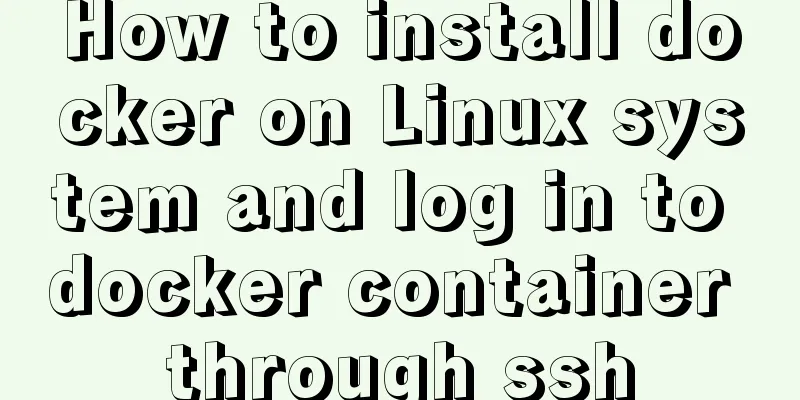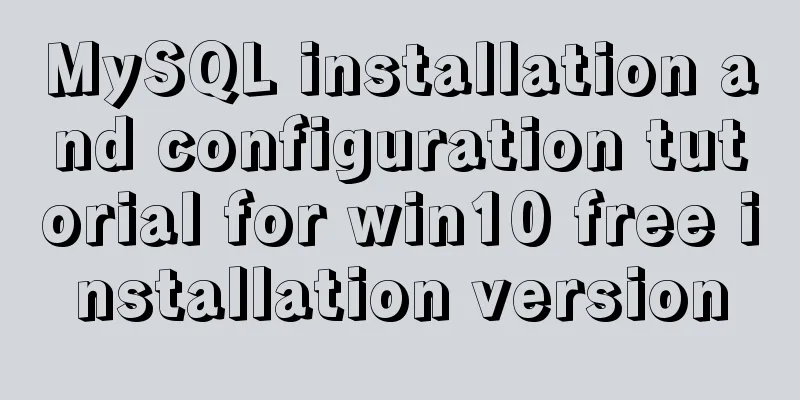Enterprise-level installation tutorial using LAMP source code

LAMP architecture(Built on the same server) 1.Lamp IntroductionLamp is a set of open source software for dynamic websites or servers consisting of linux+apache+mysql/mariadb+php/perl/python. Except for linux, other parts are various independent programs, which are often used together and have strong compatibility, forming a powerful web application platform. Linux (operating system), Apache (HTTP server), Mysql (mariadb, database software), PHP (perl or python), build web application platform 2. Web service workflowWeb server resources are divided into two categories: static and dynamic resourcesStatic resources: static content, the expression form of the resources obtained by the client from the server is the same as the source file. It is the resources stored directly in the file system (.mp3/.mp4/.jpg/.gif) Dynamic resources: usually program files, which need to be executed on the server and then return the executed structure to the client (.php/.asp/.py/.net) How does a web server process client requests?
Stage 1 shows that the httpd server (apache) and the php server communicate via the fastCGI protocol, and php runs as a separate service process. Stage 2 shows that the PHP server and the MySQL server communicate through the MySQL protocol. PHP has no connection with MySQL itself, but programs written in PHP can interact with MySQL. Similarly, programs written in Python and Perl can also interact with MySQL databases. 2.1cgi and fastcgiCGI (common gateway interface)CGI is the interface standard between external applications (CGI programs) and web services, and is the process of transmitting information between CGI programs and web servers. The CGI specification allows web servers to execute external programs and send their output to the web server, turning a set of simple static hypermedia documents on the web into a complete interactive media. FastCGI (Fast common Gateway Interface) is an improved version of CGICGI processes each task request by starting an interpreter process, which is time-consuming and resource-intensive. FastCGI processes each request in a master-worker form. It starts a master process and starts several worker processes according to the configuration. When a request comes in, the master selects one from the worker process to process the request. This avoids repeated generation and frequent CPU consumption caused by killer processes. 2.2 httpd and php combinationPHP and httpd three ways:
FastCGI is most commonly used, and few people use CGI to load dynamic resources. 2.3 Web Workflow
3.LAMP platform constructionenvironment:
The order of lamp installation:
Note that PHP requires httpd to be installed using prefock MPM and lamp is used for installation 3.1 Install httpd
#redhat source[root@clq ~]# cat /etc/yum.repos.d/CentOS-Stream-
CentOS-Stream-AppStream.repo CentOS-Stream-HighAvailability.repo
CentOS-Stream-BaseOS.repo CentOS-Stream-Media.repo
CentOS-Stream-Debuginfo.repo CentOS-Stream-PowerTools.repo
CentOS-Stream-Extras.repo CentOS-Stream-RealTime.repo
#Install epel source [root@clq ~]# yum -y install epel-release
#View package group [root@clq ~]# yum grouplist
#Install package group [root@clq ~]# dnf -y groups mark install "Development Tools"
#Create apache user [root@clq ~]# useradd -r -M -s /sbin/nologin apache
#Install dependent packages (openssl-devel: encrypted transmission module)
[root@cb ~]# yum -y install openssl-devel pcre-devel expat-devel libtool gcc gcc-c++ make
#Download and install apr, apr-util and httpd
[root@cb ~]# cd /usr/src/
#Use wget to download three packages#Tar decompress the package#Enter the apr package to modify [root@cb apr-1.7.0]# vim configure
cfgfile="${ofile}T"
trap "$RM \"$cfgfile\";exit 1" 1 2 15
$RM "$cfgfile" #Delete or comment this line #apr compilation three steps./configure --prefix=/usr/local/apr
make
make install
#apr-util compile three steps./configure --prefix=/usr/local/apr-util --with-apr=/usr/local/apr
make
make install
#httpd compile three steps./configure --prefix=/usr/local/apache \
--sysconfdir=/etc/httpd24 \
--enable-so \
--enable-ssl \
--enable-cgi \
--enable-rewrite \
--with-zlib \
--with-pcre \
--with-apr=/usr/local/apr \
--with-apr-util=/usr/local/apr-util/ \
--enable-modules=most \
--enable-mpms-shared=all \
--with-mpm=prefork
make
make install
#After installing, configure environment variables: echo 'export PATH=/usr/local/apache/bin:$PATH' > /etc/profile.d/apache.sh
Read: source /etc/profile.d/httpd.sh
Header file mapping: ln -s /usr/local/apache/include /usr/include/httpd
Help document: vim /etc/man_db.conf
22 MANDATORY_MANPATH /usr/local/share/man
23 MANDATORY_MANPATH /usr/local/apache/man
#Uncomment ServerName (the warning message is irrelevant)
[root@cb src]# vim /etc/httpd24/httpd.conf
ServerName
#Start Apache
[root@cb src]# systemctl stop firewalld
[root@cb src]# systemctl disables firewalld
[root@cb src]# /usr/local/apache/bin/apachectl start
[root@cb src]# ss -antl
State Recv-Q Send-Q Local Address:Port Peer Address:Port Process
LISTEN 0 128 0.0.0.0:22 0.0.0.0:*
LISTEN 0 128 *:80 *:*
LISTEN 0 128 [::]:22 [::]:*
#Note to delete the system's own apache
#Write the service file to realize automatic startup #Write the httpd.service file:
vim /etc/systemd/system/httpd.service
Two specific paths in the file:
.Configuration file path: /etc/httpd24/httpd.conf
.Program file path: /usr/local/apache/bin/httpd
#System loading file: systemctl daemon-reload
#Start systemctl start httpd
#Self-start systemctl enable httpd
[root@clq ~]# vim /etc/systemd/system httpd.service
[root@clq system]# cat httpd.service
[Unit]
Description=Start httpd
[Service]
Type=simple
EnvironmentFile=/etc/httpd24/httpd.conf
ExecStart=/usr/local/apache/bin/httpd -k start -DFOREGROUND
ExecReload=/usr/local/apache/bin/httpd -k graceful
ExecStop=/bin/kill -WINCH ${MAINPID}
[Install]
WantedBy=multi-user.target
3.2 Install MySQL
#Install dependent packages (cmake: compile automatic configuration tool)
dnf -y install ncurses-devel openssl-devel openssl cmake mariadb-devel
#Create user useradd -r -M -s /sbin/nologin mysql
#Download mysql5.7.31 package #Unzip and put it in /usr/local #Change the name for easy operation cd /usr/local
mv mysql5.7.31 mysql
#Change the owner chown -R mysql.mysql mysql/
#Environment variable echo 'export PATH=/usr/local/mysql/bin:$PATH' > /etc/profile.d/mysql.sh
source /etc/profile.d/mysql.sh
#Header file mapping ln -s /usr/local/mysql/include /usr/include/mysql
#Library file vim /etc/ld.so.conf.d/mysql.conf
/usr/local/mysql/lib
ldconfig #Re-read the help document vim /etc/man_db.conf
23 MANDATORY_MANPATH /usr/local/apache/man
24 MANDATORY_MANPATH /usr/local/mysql/man
#Create data directory mkdir /opt/data
chown -R mysql.mysql /opt/data
# Initialize mysqld --initialize --user=mysql --datadir=/opt/data
#Write configuration file cat >/etc/my.cnf <<EOF
[mysqld]
basedir = /usr/local/mysql #installation directorydatadir = /opt/data #data directorysocket = /tmp/mysql.sock #socketuser = mysql #userport = 3306 #port numberpid-file = /opt/data/mysql.pid #process number fileskip-name-resolve #skip domain name resolutionEOF exit#write scriptcp /usr/local/mysql/support-files/mysql.server /etc/init.d/mysqld
vim /etc/init.d/mysqld
datadir=/opt/data
basedir=/usr/local/mysql
#Start mysql
service mysqld start
ss-antl
#Install the libncurses.so.5 package yum whatprovides libncurses.so.5
yum -y install ncurses-compat-libs
#Modify mysql password set password=password('Centos8.0!')
# Ensure that chkconfig --add mysqld starts automatically at boot time
chkconfig mysqld on
chkconfig --list
3.3 Install PHP#centos8 can install php with yum. php is a language. Install version 7.2 or above. yum -y install php* 3.4 Configure PHP#php configuration vim /etc/php-fpm.d/www.conf 38 ;listen = /run/php-fpm/www.sock #Uncomment 39 listen = 127.0.0.1:9000 #Add this line 65 listen.allowed_clients = 127.0.0.1 mkdir -p /data/php #Create php directory chown -R apache.apache /data/ #Change the owner vim /data/php/index.php #Write index.php file phpinfo(); ?> #Restart systemctl restart php-fpm.service 3.4.4PHP compilation and installationCentOS 8 and earlier versions //Configure yum source [root@localhost ~]# wget http://rpms.remirepo.net/enterprise/remi-release-7.rpm [root@localhost ~]# rpm -Uvh remi-release-7.rpm [root@localhost ~]# yum makecache --enablerepo=remi-php74 //Install dependent packages[root@localhost ~]# yum -y install libxml2 libxml2-devel openssl openssl-devel bzip2 bzip2-devel libcurl libcurl-devel libicu-devel libjpeg libjpeg-devel libpng libpng-devel openldap-devel pcre-devel freetype freetype-devel gmp gmp-devel libmcrypt libmcrypt-devel readline readline-devel libxslt libxslt-devel mhash mhash-devel php72-php-mysqlnd The installation process is brief... //Download php [root@localhost ~]# cd /usr/src/ [root@localhost src]# wget http://cn.php.net/distributions/php-7.2.8.tar.xz Download process briefly.... //Compile and install PHP [root@localhost src]# tar xf php-7.2.8.tar.xz [root@localhost src]# cd php-7.2.8 [root@localhost php-7.2.8]# ./configure --prefix=/usr/local/php7 \ --with-config-file-path=/etc \ --enable-fpm \ --enable-inline-optimization \ --disable-debug \ --disable-rpath \ --enable-shared \ --enable-soap \ --with-openssl \ --enable-bcmath \ --with-iconv \ --with-bz2 \ --enable-calendar \ --with-curl \ --enable-exif \ --enable-ftp \ --with-gd \ --with-jpeg-dir \ --with-png-dir \ --with-zlib-dir \ --with-freetype-dir \ --with-gettext \ --enable-json \ --enable-mbstring \ --enable-pdo \ --with-mysqli=mysqlnd \ --with-pdo-mysql=mysqlnd \ --with-readline \ --enable-shmop \ --enable-simplexml \ --enable-sockets \ --enable-zip \ --enable-mysqlnd-compression-support \ --with-pear \ --enable-pcntl \ --enable-posix [root@localhost php-7.2.8]# make -j $(cat /proc/cpuinfo |grep processor|wc -l) The compilation process is omitted [root@localhost php-7.2.8]# make install Installation process omitted // Post-installation configuration [root@localhost ~]# echo 'export PATH=/usr/local/php7/bin:$PATH' > /etc/profile.d/php7.sh [root@localhost ~]# source /etc/profile.d/php7.sh //Post-installation configuration [root@localhost ~]# echo 'export PATH=/usr/local/php7/bin:$PATH' > /etc/profile.d/php7.sh [root@localhost ~]# source /etc/profile.d/php7.sh [root@localhost php-7.2.8]# which php /usr/local/php7/bin/php [root@localhost php-7.2.8]# php -v PHP 7.2.8 (cli) (built: Aug 16 2018 13:27:30) ( NTS ) Copyright (c) 1997-2018 The PHP Group Zend Engine v3.2.0, Copyright (c) 1998-2018 Zend Technologies //Configure php-fpm [root@localhost php-7.2.8]# cp php.ini-production /etc/php.ini [root@localhost php-7.2.8]# cp sapi/fpm/init.d.php-fpm /etc/init.d/php-fpm [root@localhost php-7.2.8]# chmod +x /etc/rc.d/init.d/php-fpm [root@localhost php-7.2.8]# cp /usr/local/php7/etc/php-fpm.conf.default /usr/local/php7/etc/php-fpm.conf [root@localhost php-7.2.8]# cp /usr/local/php7/etc/php-fpm.d/www.conf.default /usr/local/php7/etc/php-fpm.d/www.conf //Edit the php-fpm configuration file (/usr/local/php7/etc/php-fpm.conf): //Configure the fpm-related options to the values you need: [root@localhost ~]# vim /usr/local/php7/etc/php-fpm.conf ..... ..... pm.max_children = 50; Provide up to 50 processes at the same time and provide 50 concurrent services pm.start_servers = 5; Start 5 processes at startup pm.min_spare_servers = 2; Minimum number of idle processes pm.max_spare_servers = 8; Maximum number of idle processes [root@localhost ~]# tail /usr/local/php7/etc/php-fpm.conf ; file. ; Relative path can also be used. They will be prefixed by: ; - the global prefix if it's been set (-p argument) ; - /usr/local/php7 otherwise include=/usr/local/php7/etc/php-fpm.d/*.conf pm.max_children = 50 pm.start_servers = 5 pm.min_spare_servers = 2 pm.max_spare_servers = 8 //Start php-fpm [root@localhost ~]# service php-fpm start Starting php-fpm done //By default, fpm listens on port 9000 of 127.0.0.1. You can also use the following command to verify whether it is listening on the corresponding socket [root@localhost ~]# ss -antl State Recv-Q Send-Q Local Address:Port Peer Address:Port LISTEN 0 128 *:22 *:* LISTEN 0 100 127.0.0.1:25 *:* LISTEN 0 128 127.0.0.1:9000 *:* LISTEN 0 128 :::80 :::* LISTEN 0 128 :::22 :::* LISTEN 0 100 ::1:25 :::* LISTEN 0 80 :::3306 :::* [root@localhost ~]# ps -ef|grep php root 81070 1 0 14:13 ? 00:00:00 php-fpm: master process (/usr/local/php7/etc/php-fpm.conf) nobody 81071 81070 0 14:13 ? 00:00:00 php-fpm: pool www nobody 81072 81070 0 14:13 ? 00:00:00 php-fpm: pool www nobody 81073 81070 0 14:13 ? 00:00:00 php-fpm: pool www nobody 81074 81070 0 14:13 ? 00:00:00 php-fpm: pool www nobody 81075 81070 0 14:13 ? 00:00:00 php-fpm: pool www root 81079 83354 0 14:15 pts/1 00:00:00 grep --color=auto php 3.5 Configure ApacheApache 2.4 and later has an implementation for FastCGI, the module is mod_proxy_fcgi.so, it is actually an extension of the mod_proxy.so module, so both modules must be loaded, edit the httpd.conf file, uncomment the two lines vim /etc/httpd24/httpd.conf LoadModule proxy_module modules/mod_proxy.so LoadModule proxy_fcgi_module modules/mod_proxy_fcgi.so Or modify with sed: sed -i '/proxy_module/s/#//g' /etc/httpd24/httpd.conf sed -i '/proxy_fcgi_module/s/#//g' /etc/httpd24/httpd.conf Apache yum installation web page file path: /var/www/html Apache source code installation web page file path: /usr/local/apache/htdocs Configuring Virtual Hosts Add two lines to the virtual host that needs to use fcgi: ProxyRequests Off #Turn off forward proxy ProxyPassMatch ^/(.*\.php)$ fcgi://127.0.0.1:9000/网页目录/redhat.com/$1 #The above settings mean that files ending with .php are sent to the php-fpm process. php-fpm needs to know at least the directory and URL of the running process. These two parameters are named after fcgi. Other parameters are encapsulated by mod——proxy_fcgi.so and do not need to be specified manually. #redhat is the domain name#$1 means matching all httpd requests ending with .php /etc/httpd24/httpd.conf #Main configuration file [root@clq ] vim /etc/httpd24/httpd.conf #Enter the main configuration file to add a virtual host configuration file [root@clq ] vim /etc/httpd24/extra/vhosts.conf #Edit the virtual host configuration file <VirtualHost *:80> DocumentRoot "/data/php/" #File storage path ServerName www.clq.com #Domain name DirectoryIndex index.php ProxyRequests Off ProxyPassMatch ^/(.*\.php)$ fcgi://127.0.0.1:9000/data/php/$1 <Directory "/data/php/"> Options none AllowOverride none Require all granted </Directory> </VirtualHost> [root@clq] vim /etc/httpd24/httpd.conf 203 ServerName 0.0.0.0.com:80 #Modify 261 DirectoryIndex index.php index.html #Add index.php in the middle 399 AddType application/x-httpd-php .php #Add this line 400 AddType application/x-httpd-php-source .phps #Add this line 488 # 489 Include /etc/httpd24/httpd/extra/vhosts.conf #Add this line#Restart systemctl restart httpd
4. Blog Creation 1Download address: https://wordpress.org/download/#download-install #Unzip the package [root@clq ~]# unzip wordpress-5.7.2.zip #Put all the unzipped packages in /data/php [root@clq ~]# mv wordpress/* /data/php/ Visit again:
#Database permissionsmysql> grant all on *.* to root@'192.168.136.219' identified by 'huawei@123'; Query OK, 0 rows affected, 1 warning (0.00 sec) mysql> flush privileges; Query OK, 0 rows affected (0.00 sec) #Create database wordpress mysql> create database wordpress; 5. Selective use of service startup configuration
The above is the detailed content of the tutorial on how to install LAMP source code for enterprises. For more information about installing LAMP source code for enterprises, please pay attention to other related articles on 123WORDPRESS.COM! You may also be interested in:
|
<<: JavaScript data flattening detailed explanation
>>: How to use the flash plug-in to call the PC's camera and embed it into the TML page
Recommend
Tutorial on downloading, installing and deploying Tomcat to IDEA (with two hot deployment setting methods for IDEA)
Table of contents Tomcat Download Tutorial Tomcat...
Reasons why MySQL queries are slow
Table of contents 1. Where is the slowness? 2. Ha...
Win10 installation of MySQL5.7.18winX64 failed to start the server and no error message
System environment: Win10 64-bit MySQL version: m...
Native js to realize the upload picture control
This article example shares the specific code of ...
MySQL learning database backup detailed explanation
Table of contents 1.DB,DBMS,SQL 2. Characteristic...
W3C Tutorial (14): W3C RDF and OWL Activities
RDF and OWL are two important semantic web techno...
A brief analysis of the event delegation mechanism and deep and shallow copying in JavaScript
Table of contents 1. Event delegation Event Bubbl...
Using trap to perform environment cleanup before graceful shutdown of docker container
When a running container is terminated, how can w...
A brief analysis of CSS :is() and :where() coming to browsers soon
Preview versions of Safari (Technology Preview 10...
A brief discussion on the pitfalls and solutions of the new features of MySQL 8.0 (summary)
1. Create users and authorize Creating users and ...
Two ways to enable firewall in Linux service
There are two ways: 1. Service method Check the f...
Super detailed steps to install zabbix3.0 on centos7
Preface Recently, part of the company's busin...
Solution to Django's inability to access static resources with uwsgi+nginx proxy
When deploying uwsgi+nginx proxy Django, access u...
Installation tutorial of mysql 5.7 under CentOS 7
1. Download and install the official MySQL Yum Re...
Docker container custom hosts network access operation
Adding the extra_hosts keyword in docker-compose....













